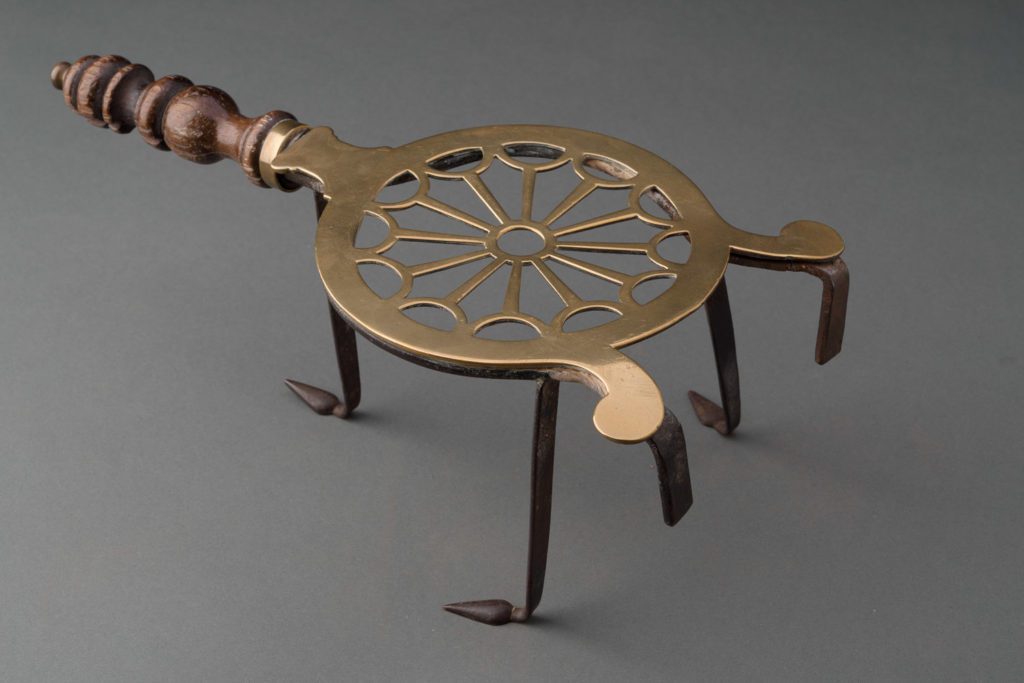Trivets Are Hot Collectibles
By • March 26, 2019 0 8930

Picture a romantic, snowy evening: fireside, burning logs, shining brass firedogs and a hot iron trivet on the hearth. But, you may ask, what, exactly, is the trivet in that picture?
Simply put, a trivet is a metal stand that stood in the fireplace or on the hearth, upon which a kettle or a pot was placed when it was not actually hanging over the fire. Widely used in the 17th century, trivets were needed in the home for multiple daily household tasks.
They likely had three legs attached to a circular plate with a strengthening stretcher between the legs. This is probably why they were also known as “spiders,” for when a pan was removed, the three legs resembled a spider. The “cat” was still another form of 18th-century trivet. Made up of six spokes and a central body, it could be used either side up.
But trivets are more than hardcore potholders. Short-legged trivets sat on stovetops to aid in slow cooking and raised hot pans above tabletops. Long-legged trivets perched in fireplaces for resting very hot, sooty pokers. Also, multiple trivets were placed on or near ironing boards to secure hot irons. Antique trivets, made in the 19th and early 20th century, are commonly made of cast iron or brass, straight out of the Industrial Revolution. The trivets intended to hold irons usually had a V-shape that closely fit the base of the iron itself. Because they were metal, some open- fire trivets incorporated longer handles to facilitate moving them while hot. The long pole eased the lifting of a hot trivet from a distance, but because those handles could get pretty hot — and perhaps burn up — many had hollow handles, so that new wooden poles could fit inside.
Although most 19th-century trivets are made of cast iron, other old trivets are made from brass, an alloy of copper and zinc, and bronze, an alloy of copper and tin. Bronze trivets were made mostly from about 1850 to 1900; it is very doubtful that any bronze trivets were cast in the 20th century. Aluminum and aluminum alloys are modern, 20th-century materials. There are no old aluminum trivets.
In places in the world where iron was not readily available, some early trivets were made of tile. They have insulating properties that metal trivets do not (and thus do not need legs). Tile trivets in America are mostly from the late 19th or 20th century and were manufactured by many makers of fine china and porcelain, from Wedgwood to Rosenthal to Limoges. These trivets, often beautifully hand-painted, frequently had raised edges to frame the bottoms of whatever was placed upon them.
In addition to the material from which they were made, antique iron trivets can be dated by their casting marks, or sprue marks, indicating that an iron was made before 1865. These are marks left behind where the liquid metal was poured into a mold and excess material solidified. A sprue mark can come in the form of a circle mark or a thin line known as a wedge mark — basically the trivet’s belly button. Trivets made after 1860 would have gate marks, which are similar to wedge marks, but can be found along the seam of the trivet mold.
Even though authentic early trivets rarely bear a maker’s mark, examples may feature an owner’s initials. Over the years, designs were cast by many different foundries and rarely signed, although there are exceptions. Master moulder William B. Rimby of Baltimore cast some beautiful trivets between 1841 and 1843; most were signed and dated and bear his initials on the reverse of the handle. Rimby’s trivets are rare and very collectible.
Cast iron trivets were first widely reproduced in the 1930s. In later decades, brass trivets began arriving from China, Japan and India. Use of trivets faded as households acquired central heating and cast iron cooking wares were supplanted by modern ceramics. However, interest in trivets reappeared in the 1960s as a form of kitchen decoration, and patterns and materials proliferated.
Trivets are a collectible accessible to nearly everyone. The price for authentic, early trivets can range from $50 to several hundred dollars for a marked, early piece. But given the general lack of identifying marks on early pieces, there are a few signs that should be considered when the collector seeks authenticity. Check for identifying marks — or the lack thereof — that will aid in dating.
A few tips: old iron has a smooth, fine- grained surface whereas new iron is rough textured, jagged edged and coarse grained and has a gray appearance. Genuine old American trivets are usually unmarked on the back. Be suspicious of trivets with markings or numbers on the back side. The mark “Taiwan” was not used until about 1959, so there are no antique trivets marked Taiwan. If you see casting gates, distinct metal stubs usually found sticking out from along the mold seam, the trivet is not antique.
Many newer reproductions show recently formed reddish-brown “rust.” Old rust is deep brown, almost black. Old trivets were smoothed with a file by hand, so beware of deep, circular grinding marks. Original trivets were painted a glossy black, which has dulled over the years. Also, old paint will show wear in logical points of heaviest use such as handles, edges, raised design and always on the feet. Finally, the signs of authentic wear are the result of years of honest use — and hard to copy.
Michelle Galler is an antiques dealer, a design consultant and a realtor based in both Washington, D.C., and Washington, Virginia. Her shop is in Hazel River Arts & Antiques in Sperryville, Virginia. Reach her at antiques.and.whimsies@gmail.com.

